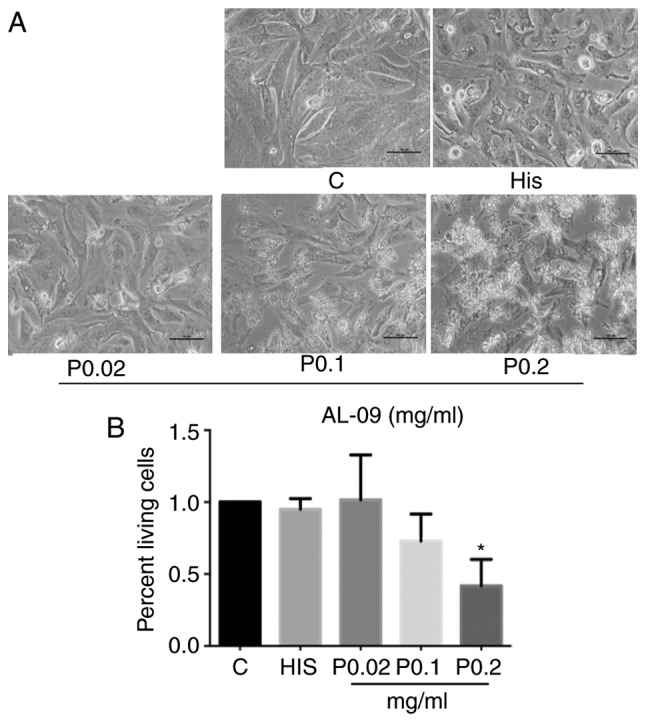The current examine aimed to research the poisonous results of totally different amyloidogenic light-chains (LCs) on cardiomyocytes, and show the differentially expressed genes (DEGs) and signaling pathways that take part on this course of.
Cultured cardiomyocytes have been handled with recombinant κ LC peptide (AL-09) or with serum from a affected person identified with a number of myeloma (λ LC) with cardiac involvement. The 6xHis peptide or serum from wholesome sufferers was used as peptide management or serum management, respectively. Cell viability was decided utilizing CCK-Eight assay and apoptosis was analyzed by movement cytometry.

The DEGs have been detected by RNA sequencing (RNA-Seq), adopted by Gene Ontology and Kyoto Encyclopedia of Genes and Genomes (KEGG) analyses. Changes in gene expression ranges have been confirmed by reverse transcription-quantitative PCR. The cell viability within the AL-09 peptide-treated (0.2 mg/ml) and affected person serum-treated (1:10 dilution) cardiomyocytes decreased to 42 and -72% of the corresponding management teams.
The extent of cell apoptosis elevated in AL-09-treated cardiomyocytes in contrast with the management group. RNA-Seq confirmed 256 DEGs co-existed within the two paired teams, together with 127 upregulated and 88 downregulated genes. The KEGG pathways for upregulated expressed genes included the ‘TGF-β signaling pathway’, the ‘Hedgehog signaling pathway’, the ‘ErbB signaling pathway’ and ‘lysine degradation’.
The larger mRNA expression of bone morphogenetic protein (Bmp) 4, Bmp6, prostaglandin G/H synthase (Ptgs)1, Ptgs2, epiregulin, Tgfa and procollagen-lysine,2-oxoglutarate 5-dioxygenase 2 have been confirmed. The KEGG pathways of downregulated expressed genes included genes concerned with the ‘p53 signaling pathway’ and the ‘cell cycle’. The mRNA expression ranges of E3 ubiquitin-protein ligase CCNB1IP1 confirmed important downregulation within the AL-09 peptide group in contrast with these within the 6xHis peptide group.
In conclusion, cardiomyocytes handled with amyloidogenic λ and κ LCs introduced with decreased cell viability in contrast with controls. Cell apoptosis elevated in κ LC-treated cells in contrast with controls. The gene expression profiles related to reworking development factor-β-bone morphogenetic protein, the receptor tyrosine-protein kinase erbB-2 signaling pathways, prostaglandins, collagen manufacturing, the p53 signaling pathway and the cell cycle have been altered in light-chain-treated cardiomyocytes.
The impact of hint components on BMP-2, BMP-7 and STRO-1+ cells in hip alternative
To discover the correlation between the hint components within the proximal femur and BMP-2, BMP-7 and STRO-1+ cells in hip alternative, and analyze the therapeutic impact of prosthesis loosening in clinic. Fifty-one sufferers undergone the primary hip alternative in xxx hospital from August 2016 to August 2019 have been chosen because the examine topics, together with 26 females and 25 males, aged 52-89 years.
The bone marrow mesenchymal stem cells (BMSCs) have been cultured in vitro for movement cytometry, and the string-1+ in BMSCs was detected and analyzed. After that, the expression of bone morphogenetic protein 2 (BMP-2) and bone morphogenetic protein 7 (BMP-7) within the cells have been detected by enzyme-linked immunosorbent assay, the content material of hint components within the supernatant was detected by radioimmunoassay, and the collected knowledge have been analyzed statistically.
In the evaluation of the content material of hint components, it was discovered that the correlation between hint components was dependent on the separation space, and all hint components had no correlation with BMP2. Ca2+, Mg2+ have been correlated with the extent of BMP7 and Ca2+, VD3 was correlated with the share of STOR-1+ cells.
Further evaluation confirmed that the correlation between hint components was dependent on bone mineral density (BMD) space, and there was a optimistic correlation between vitamin D3 (VD3), parathyroid hormone (PTH), zinc, and BMD in zone 7. To sum up, it’s discovered that hint components could also be associated to prosthesis loosening, which gives experimental foundation for the remedy of prosthesis loosening later.
The Relationship between Vitamin Ok and Osteoarthritis: A Review of Current Evidence
Vitamin Ok is a cofactor of γ-glutamyl carboxylase, which performs an essential function within the activation of γ-carboxyglutamate (gla)-containing proteins that negatively regulate calcification. Thus, vitamin Ok standing is likely to be related to osteoarthritis (OA), by which cartilage calcification performs a task within the pathogenesis of the illness.
This evaluate collates the proof on the connection between vitamin Ok standing (circulating or dietary consumption stage of vitamin Ok, or circulating uncarboxylated gla proteins) and OA from human observational research and medical trial, to look at its potential as an agent in stopping OA. The present literature usually agrees {that a} adequate stage of vitamin Ok is related to a decrease danger of OA and pathological joint options.
However, proof from medical trials is proscribed. Mechanistic examine reveals that vitamin Ok prompts matrix gla proteins that inhibit bone morphogenetic protein-mediated cartilage calcification. Gla-rich proteins additionally inhibit inflammatory cascade in monocytic cell traces, however this perform is likely to be impartial of vitamin Ok-carboxylation. Although the present knowledge are inadequate to ascertain the optimum dose of vitamin Ok to stop OA, making certain adequate dietary consumption appears to guard the aged from OA.
